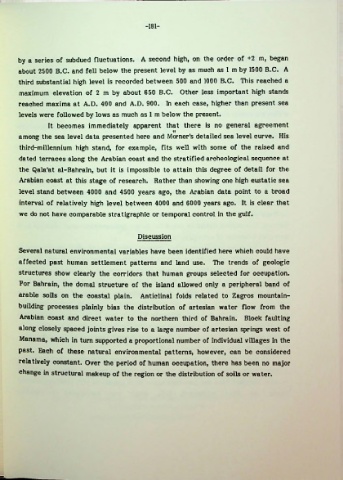Page 205 - Life & Land Use on the Bahrain Islands (Curtis E Larsen)
P. 205
-181-
by a series of subdued fluctuations. A second high, on the order of +2 m, began
about 2500 B.C. and fell below the present level by as much as 1 m by 1500 B.C. A
third substantial high level is recorded between 500 and 1000 B.C. This reached a
maximum elevation of 2 m by about 650 B.C. Other less important high stands
reached maxima at A.D. 400 and A.D. 900. In each case, higher than present sea
levels were followed by lows as much as 1 m below the present.
It becomes immediately apparent that there is no general agreement
ti
among the sea level data presented here and Morner’s detailed sea level curve. His
third-millennium high stand, for example, fits well with some of the raised and
dated terraces along the Arabian coast and the stratified archeological sequence at
the Qala'at al-Bahrain, but it is impossible to attain this degree of detail for the
Arabian coast at this stage of research. Rather than showing one high eustatic sea
level stand between 4000 and 4500 years ago, the Arabian data point to a broad
interval of relatively high level between 4000 and 6000 years ago. It is clear that
we do not have comparable stratigraphic or temporal control in the gulf.
Discussion
Several natural environmental variables have been identified here which could have
affected past human settlement patterns and land use. The trends of geologic
structures show clearly the corridors that human groups selected for occupation.
For Bahrain, the domal structure of the island allowed only a peripheral band of
arable soils on the coastal plain. Anticlinal folds related to Zagros mountain
building processes plainly bias the distribution of artesian water flow from the
Arabian coast and direct water to the northern third of Bahrain. Block faulting
along closely spaced joints gives rise to a large number of artesian springs west of
Manama, which in turn supported a proportional number of individual villages in the
past. Each of these natural environmental patterns, however, can be considered
relatively constant. Over the period of human occupation, there has been no major
change in structural makeup of the region or the distribution of soils or water.

